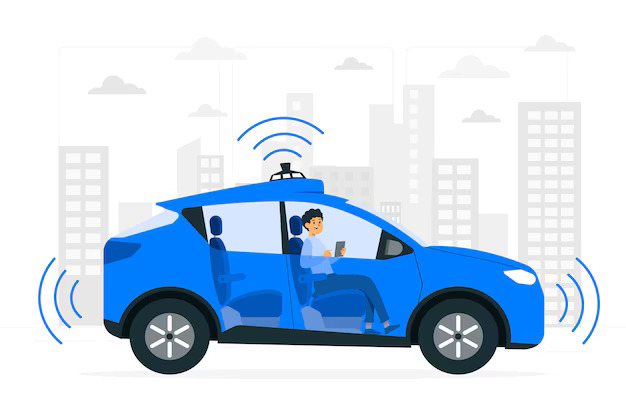Autonomous vehicles (AVs) are transforming the way we think about transportation. The emergence of autonomous technology presents a monumental shift, especially for ride-hailing apps like Uber. These platforms have already redefined urban mobility by providing a convenient, on-demand transportation service. However, the integration of autonomous cars into this ecosystem is poised to completely revolutionize the industry.
In this blog, we will explore the profound impact autonomous cars are expected to have on the future of Uber-like app development. We’ll discuss the potential benefits, problems, and changes in user experience, infrastructure, and business models of ride-hailing apps in a world where self-driving vehicles become the standard.
The Rise of Autonomous Vehicles
Before delving into the specific implications for Uber-like apps, it’s important to understand the current state of autonomous vehicle technology. Autonomous vehicles are equipped with advanced sensors, machine learning algorithms, and artificial intelligence (AI) systems that enable them to navigate the world with minimal or no human intervention.
Levels of Autonomy
The Society of Automotive Engineers (SAE) has defined six levels of driving automation, from Level 0 (no automation) to Level 5 (full automation):
- Level 0: No automation; human drivers control everything.
- Level 1: Driver assistance; features like cruise control are automated, but the driver is still in charge.
- Level 2: Partial automation; cars can handle acceleration, braking, and steering, but the driver must remain attentive.
- Level 3: Conditional automation; the car handles all tasks but requires human intervention under certain conditions.
- Level 4: High automation; vehicles can drive themselves in most conditions but may need human assistance in extreme environments.
- Level 5: Full automation; the vehicle performs all driving tasks without any human intervention.
Currently, the development of autonomous cars is somewhere between Levels 3 and 4, but experts anticipate that Level 5 autonomy will become mainstream within the next decade.
How Autonomous Cars Will Shape Uber-Like App Development
Autonomous vehicles hold immense potential to reshape the ride-hailing landscape. Here are several ways in which Uber-like apps will evolve in response to this new reality.
1. Reduction in Operating Costs
One of the biggest challenges for ride-hailing companies is the cost associated with maintaining a fleet of human drivers. Paying drivers accounts for a large portion of the cost structure in ride-hailing services. Autonomous vehicles eliminate the need for drivers, which can significantly reduce operational expenses.
Lower Driver Costs
By removing the driver from the equation, Uber-like apps can save on labor costs, insurance, and benefits typically associated with employing human drivers. This could result in lower ride prices for consumers, making ride-hailing services more affordable and accessible to a broader population.
Maintenance and Efficiency
Autonomous cars, particularly electric ones, are expected to require less maintenance compared to traditional vehicles. AI-powered systems can predict and manage vehicle performance, minimizing wear and tear. Additionally, electric AVs can optimize fuel consumption and reduce energy costs, further lowering the operational expenses of a ride-hailing fleet.
2. Enhanced Safety and Reduced Liability
One of the primary selling points of autonomous vehicles is their potential to drastically reduce accidents. Human error is a leading cause of road accidents, and self-driving cars, powered by advanced sensors and AI, are designed to follow traffic rules and make safer decisions.
Reduced Accident Rates
Autonomous vehicles are equipped with 360-degree sensors, radar, and cameras that enable them to perceive their surroundings far more effectively than human drivers. They can react faster to unexpected obstacles, reduce the likelihood of accidents, and create safer roads.
Insurance and Liability Shifts
In the event of an accident involving a self-driving car, the question of liability shifts. Rather than focusing on human drivers, insurance policies and liability laws will need to adapt to a world where accidents are more likely caused by software or hardware malfunctions. Uber-like apps may need to collaborate closely with car manufacturers and insurance companies to develop policies that reflect this new reality.
3. Transforming the User Experience
The introduction of autonomous cars will drastically alter the way users interact with ride-hailing services. The user experience in an autonomous Uber-like app will likely be more seamless, convenient, and personalized.
Personalized Services
Without the need for a human driver, the interior of the vehicle can be customized for different user preferences. Riders can enjoy personalized experiences, whether they’re commuting, relaxing, or working during their trip. Autonomous vehicles could offer entertainment systems, adjustable seating, and even workspaces, providing a more immersive experience.
On-Demand Availability
Self-driving cars could make ride-hailing services more readily available at all times. These vehicles can be strategically stationed in high-demand areas and continuously operate without needing breaks, resulting in faster response times. Additionally, AVs can serve underpopulated or underserved areas where human drivers may currently be unwilling to go, expanding the service’s reach.
4. Fleet Management and Operational Efficiency
Autonomous vehicles will introduce a new dimension of fleet management for ride-hailing services. Unlike human drivers, AVs can be centrally managed and optimized for efficiency.
Centralized Control and Dispatching
With self-driving cars, ride-hailing platforms can deploy fleets based on demand patterns, ensuring optimal availability of vehicles. Advanced algorithms can analyze data to predict peak hours, geographic areas with high demand, and routes that need more coverage. This will improve dispatch efficiency and reduce wait times for customers.
Dynamic Fleet Allocation
AV fleets can be dynamically allocated across regions based on real-time demand. For instance, during rush hours or special events, autonomous cars can be dispatched to high-demand areas automatically. This flexibility can help Uber-like apps manage their fleet more effectively and offer a higher level of service.
5. New Revenue Models and Business Opportunities
Autonomous vehicles will open up new avenues for revenue generation and business models in the ride-hailing space. Uber-like platforms may explore opportunities to diversify their services beyond traditional ride-hailing.
Subscription Services
One potential business model is a subscription-based service where users pay a monthly fee for unlimited rides or a set number of trips. Autonomous vehicles, with their lower operational costs, make this model more financially feasible for ride-hailing companies.
Autonomous Carpooling and Shuttle Services
Another opportunity is the development of autonomous carpooling or shuttle services. These services could allow multiple passengers to share a ride, further reducing the cost per trip. AI algorithms could optimize routing, ensuring efficient pick-up and drop-off locations, which would increase operational efficiency.
Partnerships with Other Industries
Uber-like platforms could also partner with other industries to create new services. For example, autonomous ride-hailing vehicles could collaborate with delivery services, combining passenger and goods transport. Additionally, partnerships with tourism companies or event organizers could allow AVs to offer guided tours or specialized transportation services.
6. Regulatory and Infrastructure Challenges
Despite the many advantages of autonomous cars, several regulatory and infrastructure challenges must be addressed before they can be fully integrated into ride-hailing platforms.
Regulatory Landscape
Governments will need to develop new regulations to accommodate autonomous vehicles on public roads. Issues related to safety, liability, data privacy, and licensing must be resolved. Additionally, AV manufacturers and ride-hailing companies will need to work closely with regulators to ensure compliance with evolving laws.
Infrastructure Upgrades
For AVs to function optimally, cities and regions will need to upgrade their infrastructure. This includes investing in smart traffic systems, dedicated lanes for autonomous vehicles, and ensuring that roads are well-maintained and equipped with the necessary sensors and communication technology.
Challenges in Implementing Autonomous Cars in Uber-Like Apps
While autonomous vehicles promise numerous benefits for Uber-like apps, there are still several challenges that need to be overcome.
High Initial Costs
The development and deployment of autonomous vehicles require significant investment in both hardware and software. While operational costs may be lower in the long run, the upfront costs for purchasing AVs, developing the necessary software, and upgrading infrastructure can be prohibitively high.
Public Acceptance and Trust
One of the key barriers to widespread adoption of autonomous vehicles is public trust. Many people are still hesitant to trust self-driving technology, particularly when it comes to safety concerns. Uber-like apps will need to invest in public awareness campaigns and provide transparent data on the safety and reliability of their autonomous fleets.
Technical Limitations
Despite rapid advancements in AI and machine learning, there are still technical limitations that could hinder the performance of autonomous cars. Weather conditions, road irregularities, and unexpected events (such as pedestrians or animals crossing the street) are challenges that AVs must be able to handle flawlessly to gain public trust.
Conclusion
Autonomous vehicles have the potential to dramatically reshape the future of Uber-like app development. From reducing operational costs and enhancing safety to transforming the user experience and unlocking new revenue models, AVs present immense opportunities for the ride-hailing industry. However, there are also significant challenges related to regulation, infrastructure, and public acceptance that must be addressed.
As technology continues to evolve and Level 5 autonomy becomes a reality, Uber-like apps will need to adapt to a new transportation landscape. The integration of autonomous cars will require ride-hailing platforms to rethink their business models, optimize their operations, and offer personalized experiences to users. The future of Uber-like app development is undoubtedly intertwined with the rise of autonomous vehicles, and the companies that embrace this shift will be the ones to thrive in the evolving mobility ecosystem.



